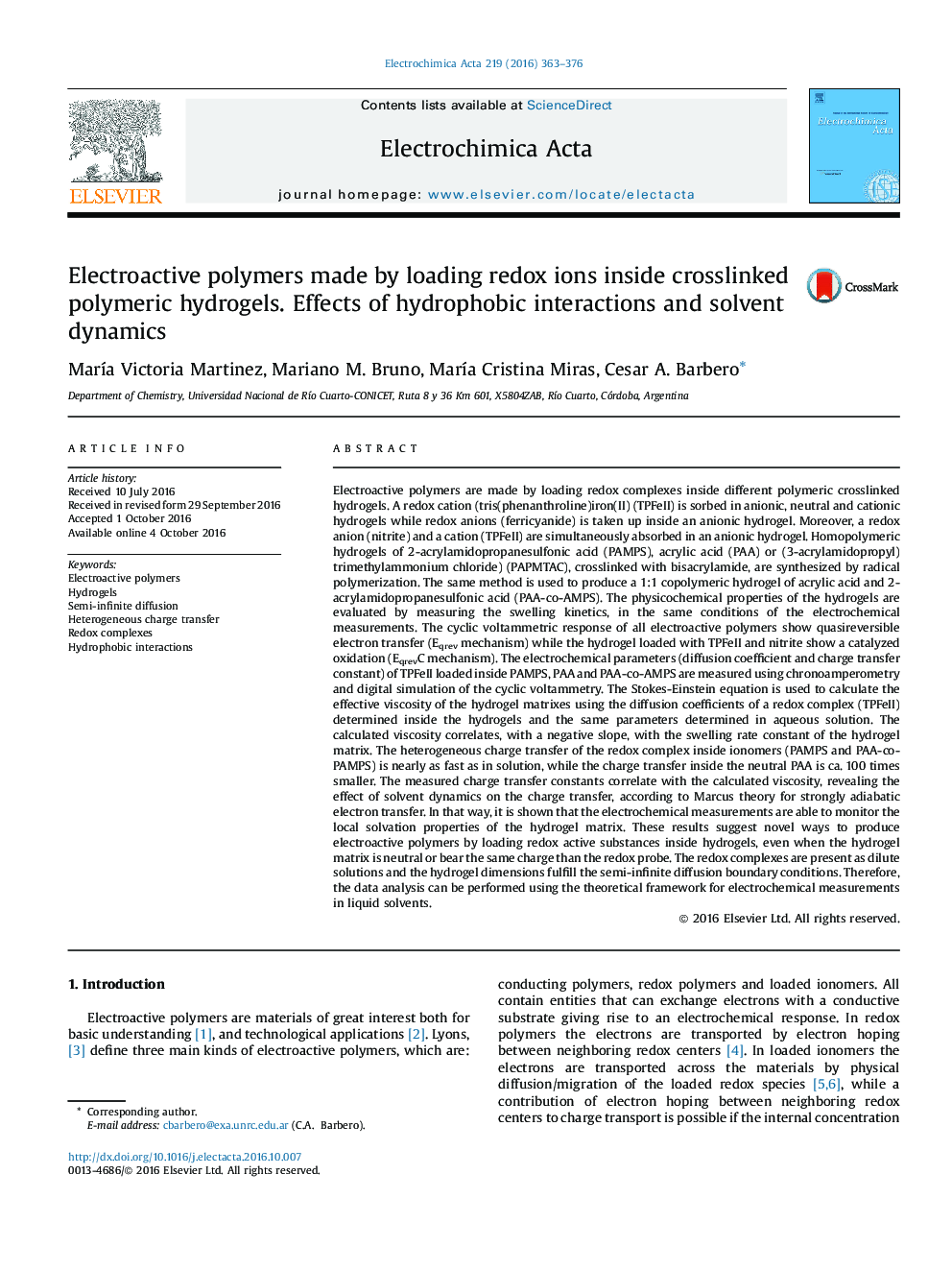| کد مقاله | کد نشریه | سال انتشار | مقاله انگلیسی | نسخه تمام متن |
|---|---|---|---|---|
| 6472933 | 1424138 | 2016 | 14 صفحه PDF | دانلود رایگان |
- Electroactive polymers are made by loading redox complexes inside hydrogels.
- Ions (anions or cations) can be loaded in hydrogels whose chains bear the same charge.
- Charge transfer depends on the hydrogel viscosity revealing solvent dynamic effects.
Electroactive polymers are made by loading redox complexes inside different polymeric crosslinked hydrogels. A redox cation (tris(phenanthroline)iron(II) (TPFeII) is sorbed in anionic, neutral and cationic hydrogels while redox anions (ferricyanide) is taken up inside an anionic hydrogel. Moreover, a redox anion (nitrite) and a cation (TPFeII) are simultaneously absorbed in an anionic hydrogel. Homopolymeric hydrogels of 2-acrylamidopropanesulfonic acid (PAMPS), acrylic acid (PAA) or (3-acrylamidopropyl)trimethylammonium chloride) (PAPMTAC), crosslinked with bisacrylamide, are synthesized by radical polymerization. The same method is used to produce a 1:1 copolymeric hydrogel of acrylic acid and 2-acrylamidopropanesulfonic acid (PAA-co-AMPS). The physicochemical properties of the hydrogels are evaluated by measuring the swelling kinetics, in the same conditions of the electrochemical measurements. The cyclic voltammetric response of all electroactive polymers show quasireversible electron transfer (Eqrev mechanism) while the hydrogel loaded with TPFeII and nitrite show a catalyzed oxidation (EqrevC mechanism). The electrochemical parameters (diffusion coefficient and charge transfer constant) of TPFeII loaded inside PAMPS, PAA and PAA-co-AMPS are measured using chronoamperometry and digital simulation of the cyclic voltammetry. The Stokes-Einstein equation is used to calculate the effective viscosity of the hydrogel matrixes using the diffusion coefficients of a redox complex (TPFeII) determined inside the hydrogels and the same parameters determined in aqueous solution. The calculated viscosity correlates, with a negative slope, with the swelling rate constant of the hydrogel matrix. The heterogeneous charge transfer of the redox complex inside ionomers (PAMPS and PAA-co-PAMPS) is nearly as fast as in solution, while the charge transfer inside the neutral PAA is ca. 100 times smaller. The measured charge transfer constants correlate with the calculated viscosity, revealing the effect of solvent dynamics on the charge transfer, according to Marcus theory for strongly adiabatic electron transfer. In that way, it is shown that the electrochemical measurements are able to monitor the local solvation properties of the hydrogel matrix. These results suggest novel ways to produce electroactive polymers by loading redox active substances inside hydrogels, even when the hydrogel matrix is neutral or bear the same charge than the redox probe. The redox complexes are present as dilute solutions and the hydrogel dimensions fulfill the semi-infinite diffusion boundary conditions. Therefore, the data analysis can be performed using the theoretical framework for electrochemical measurements in liquid solvents.
139
Journal: Electrochimica Acta - Volume 219, 20 November 2016, Pages 363-376
